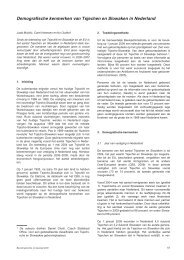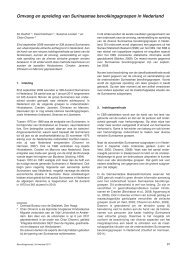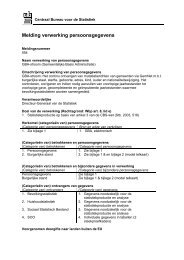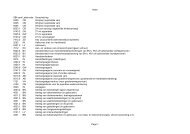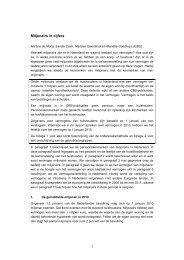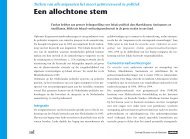Babyboomers in the Netherlands: What the statistics say - Cbs
Babyboomers in the Netherlands: What the statistics say - Cbs
Babyboomers in the Netherlands: What the statistics say - Cbs
You also want an ePaper? Increase the reach of your titles
YUMPU automatically turns print PDFs into web optimized ePapers that Google loves.
1<br />
Prolific<br />
war marriages<br />
Some 2.4 million babies were born <strong>in</strong> <strong>the</strong> Ne<strong>the</strong>rlands <strong>in</strong> <strong>the</strong><br />
period 1946–1955. These are <strong>the</strong> babies we def<strong>in</strong>e as <strong>the</strong><br />
belong<strong>in</strong>g to <strong>the</strong> post-war baby boom. The rise <strong>in</strong> <strong>the</strong> number<br />
of births started earlier, however: <strong>in</strong> 1943–1945 Dutch<br />
marriages also proved very fertile. Population growth<br />
rema<strong>in</strong>ed high <strong>in</strong> <strong>the</strong> country until <strong>the</strong> end of <strong>the</strong> 1960s.<br />
Accord<strong>in</strong>g to Statistics Ne<strong>the</strong>rlands’ demograph ers (1989),<br />
<strong>the</strong> birth wave <strong>in</strong> <strong>the</strong> years imme diately after <strong>the</strong> Second<br />
World War was caused by expecta tions that <strong>the</strong> war would<br />
end quickly after <strong>the</strong> Normandy <strong>in</strong>vasion by <strong>the</strong> western<br />
allied forces <strong>in</strong> June 1944.<br />
A quick first baby…<br />
The large numbers of baby boom births <strong>in</strong> <strong>the</strong> period<br />
1946–1949 were not <strong>the</strong> result of a real <strong>in</strong>crease <strong>in</strong> fertility.<br />
The average number of children per woman even fell <strong>in</strong><br />
<strong>the</strong> longer term. The protracted post-war birth wave was<br />
caused by more people gett<strong>in</strong>g married, and at younger<br />
ages, comb<strong>in</strong>ed with <strong>the</strong> wish to realise <strong>the</strong> desired<br />
number of children as quickly as possible after marriage,<br />
especially of couples marry<strong>in</strong>g <strong>in</strong> <strong>the</strong> last years of <strong>the</strong> war.<br />
The sharp drop <strong>in</strong> age at first birth, by more than two<br />
years, for pre-war generations of women illustrates this:<br />
women born between 1920 and 1940 married at younger<br />
ages, and also had <strong>the</strong>ir first baby at younger ages.




